Have you heard of a topic cluster? In this article, you’ll learn exactly what content marketing topic clusters are and how to leverage them for your brand. A few key benefits here include:
- Higher search engine results, page rankings, traffic, and conversions.
- Greater authority with your audience.
- Improving the results from every piece of content you publish around a given topic.
It’s time to take your content strategy and keyword research to the next level.
What Are Topic Clusters?
A topic cluster is a group of interlinked web pages. A topic cluster is a collection of web pages that link to one content pillar page from several related but more narrowly-focused pages. The content pillar page also links to these related pages, creating a hub-and-spoke model that strategically connects complementary content.
Content clustering and content clusters are synonymous with topic clusters.
Here’s a visual diagram of what a topical content cluster might look like:

For further clarification, watch this excellent brief video from Hubspot:
Topic Clusters: The Next Evolution of Content Strategy
Topic clusters are most effective for search engine optimization when the website structure creates a logical hierarchy of content that strategically links all pieces of content together. Here is a topic cluster diagram for a site structure example:
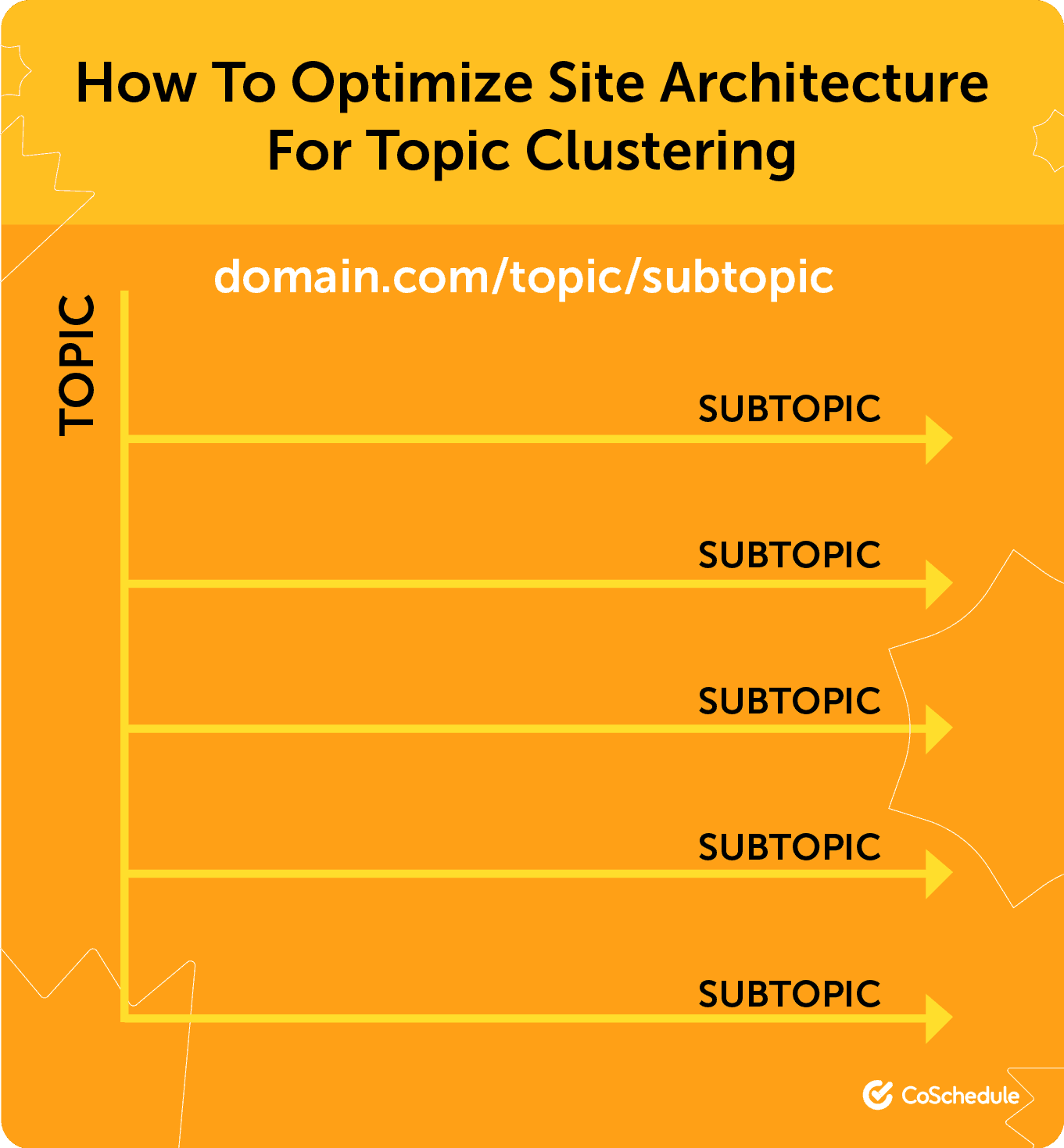
Why Are Topic Clusters Important?
Once upon a time, marketers could win by targeting a single keyword per page.
Now, targeting entire topics is the key to success. There are a few primary reasons for this:
- Personalized search has made keyword rankings more fluid. Since Google tailors search results to individual users, keyword ranking positions are harder to calculate across the board.
- Search engines are better at understanding semantically related entities. Advanced search algorithms are now better at understanding when multiple search terms are about the same thing. This means a piece of content targeting one keyword may rank for several other related terms.
- Google (and other search engines) want to provide users with authoritative and trustworthy results. One way to show your authority to searchers and bots is to consistently create useful and accurate content around a topic rather than one-off pieces targeted to particular keywords.
Collectively, this means websites that feature multiple pieces of content thoroughly addressing a given topic will generally outperform those with fewer, less authoritative pieces. As a result, the implications of this for content marketers are clear.
Focus on the big picture (and that means focusing on topics).
The benefits of the topic cluster approach are numerous, too. Here are just a few:
- They keep audiences on your site. If you have tons of content related to your visitor’s interests, they’ll likely stick around (and potentially purchase from you).
- When one piece does well, every interlinked page does better, too. Creating content around a topic often improves the search rankings of similar content on your site. This can sometimes lead to owning multiple SERP positions for a single keyword.
- They help bring in more traffic. As a result of increased rankings, you’ll bring in more visitors. And as we’ve established, they’ll be more likely to stick around on-site. This builds a positive feedback loop of increasing traffic and conversions.
Recommended: Keyword Generator
3 Topic Cluster Examples
What do topic clusters look like in the real world?
It’s easier to emulate something you can actually see, right? So, let’s take a look at three examples of sites applying the topic cluster model so you can learn from their approach.
Topic Cluster Example #1: QuickMail’s Cold Email Knowledge Base
QuickMail’s software empowers salespeople and marketers to send automated cold email cadences directly from their inboxes to increase deliverability, engagement, and replies. As such, it makes sense for the business to become the topical authority on cold email.
So QuickMail’s head of demand generation, Cristian Ungureanu, built a topic cluster for everything related to cold email strategy and tactics.
QuickMail’s cold email knowledge base has a pillar page for a nice, broad topic (e.g., cold email):
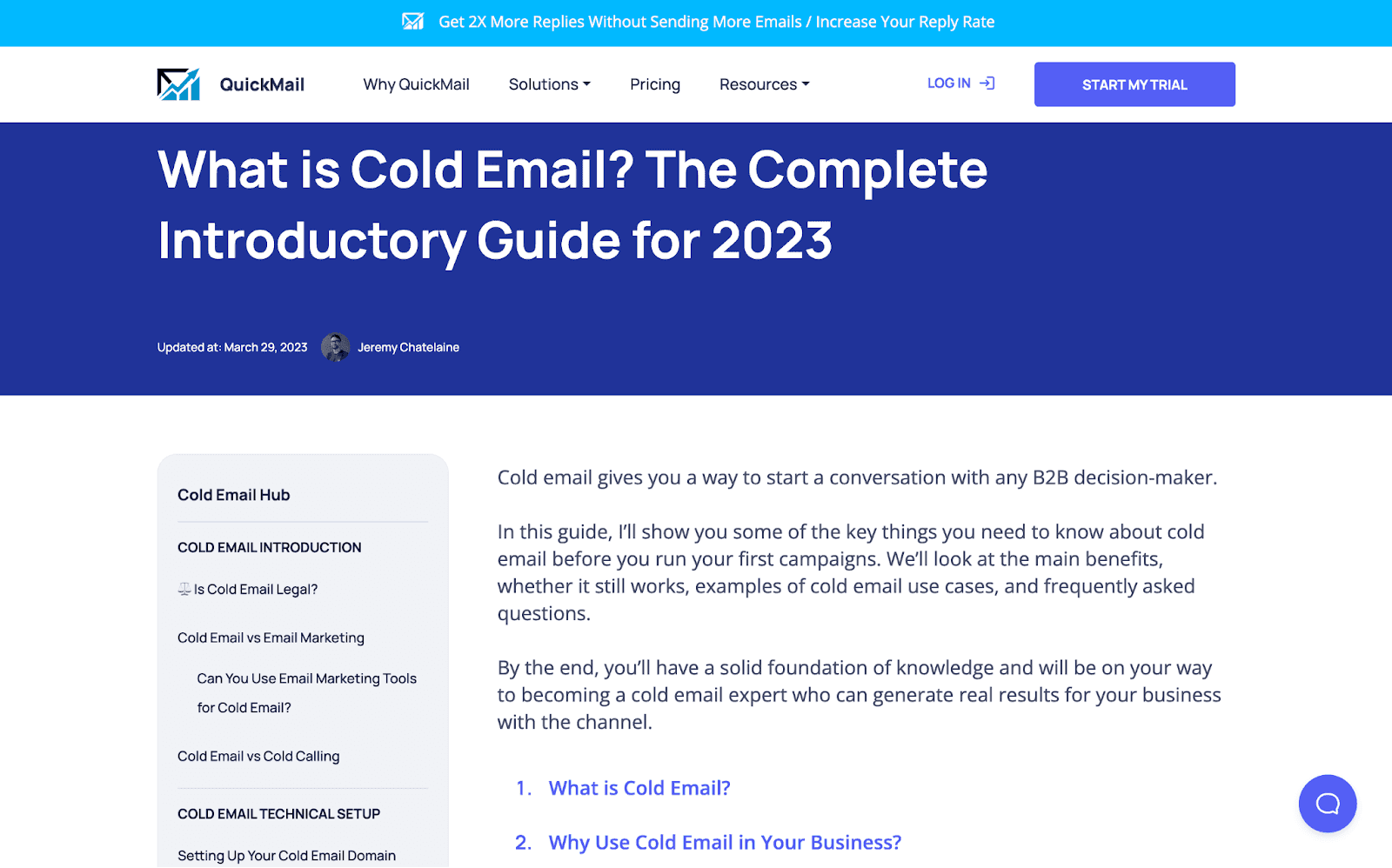
The source of this topic pillar page is linked here. This page clearly denotes cold email as the core topic of all content housed in this site area.
That dedicated cold email directory includes many nested pages within that URL structure. For example, a subtopic page is about the legality of cold email.
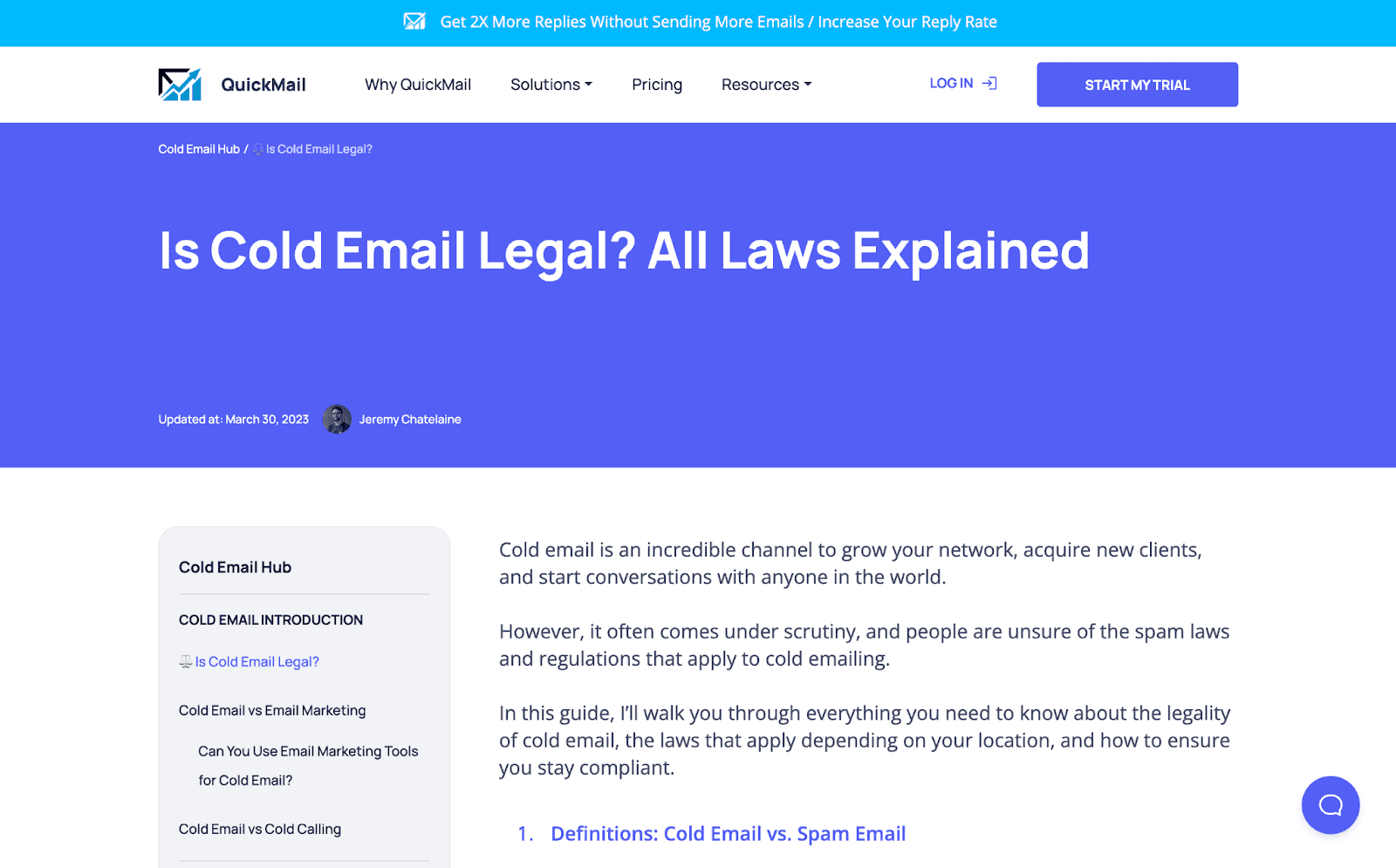
This is a good website structure to organize your content hierarchies for topic clusters. In the example above, note the breadcrumbs that contain links to the pillar page. The sidebar on the left links to all pages in the topic cluster. In addition, Cristian does an excellent job of interlinking all pages naturally within the body copy of the subtopic pages and the pillar page.
Cristian’s cold email topic cluster helped QuickMail nearly double traffic from organic search.
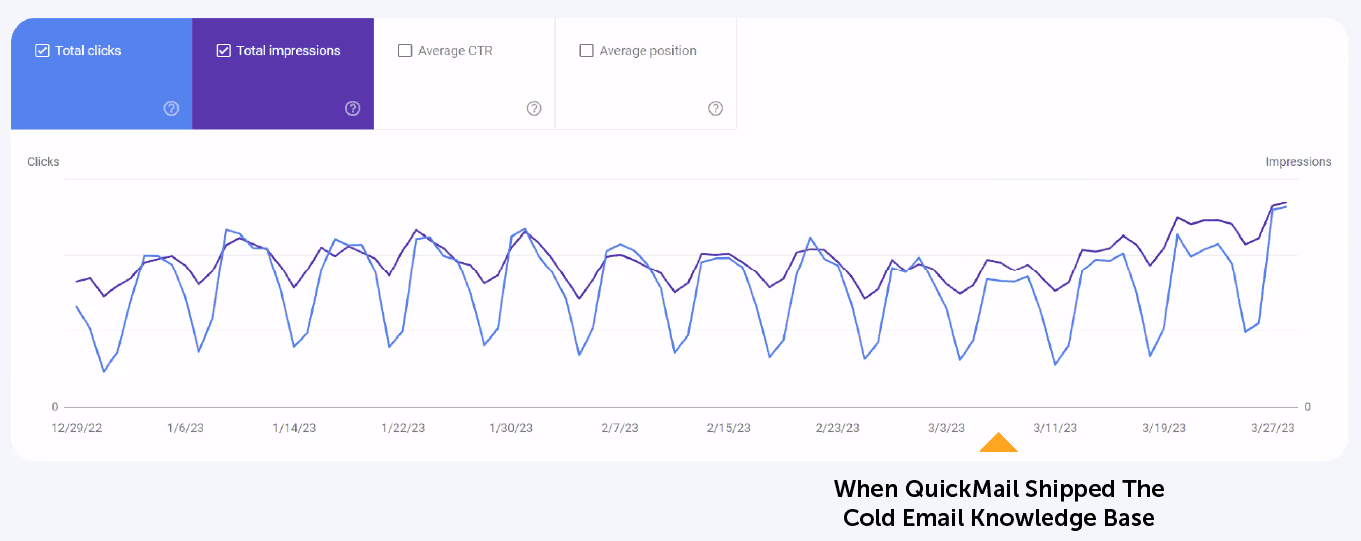
Cristian also told our former head of marketing, Nathan Ellering:
We gained rankings for about 1,200 keywords from the cold email content hub. This content already existed; we just restructured it as a topic cluster in this hub format — no new content added.
– Cristian Ungureanu
Topic Cluster Example #2: Atlassian’s Agile Coach Guide
Atlassian offers many B2B products that help customers implement agile development (and beyond) management structures. So it makes sense for them to build topical authority around everything to do with agile.
This topic cluster is well structured with a broad content pillar page of Agile.

There are many pages that contain very specific, short-form content, view an example here.
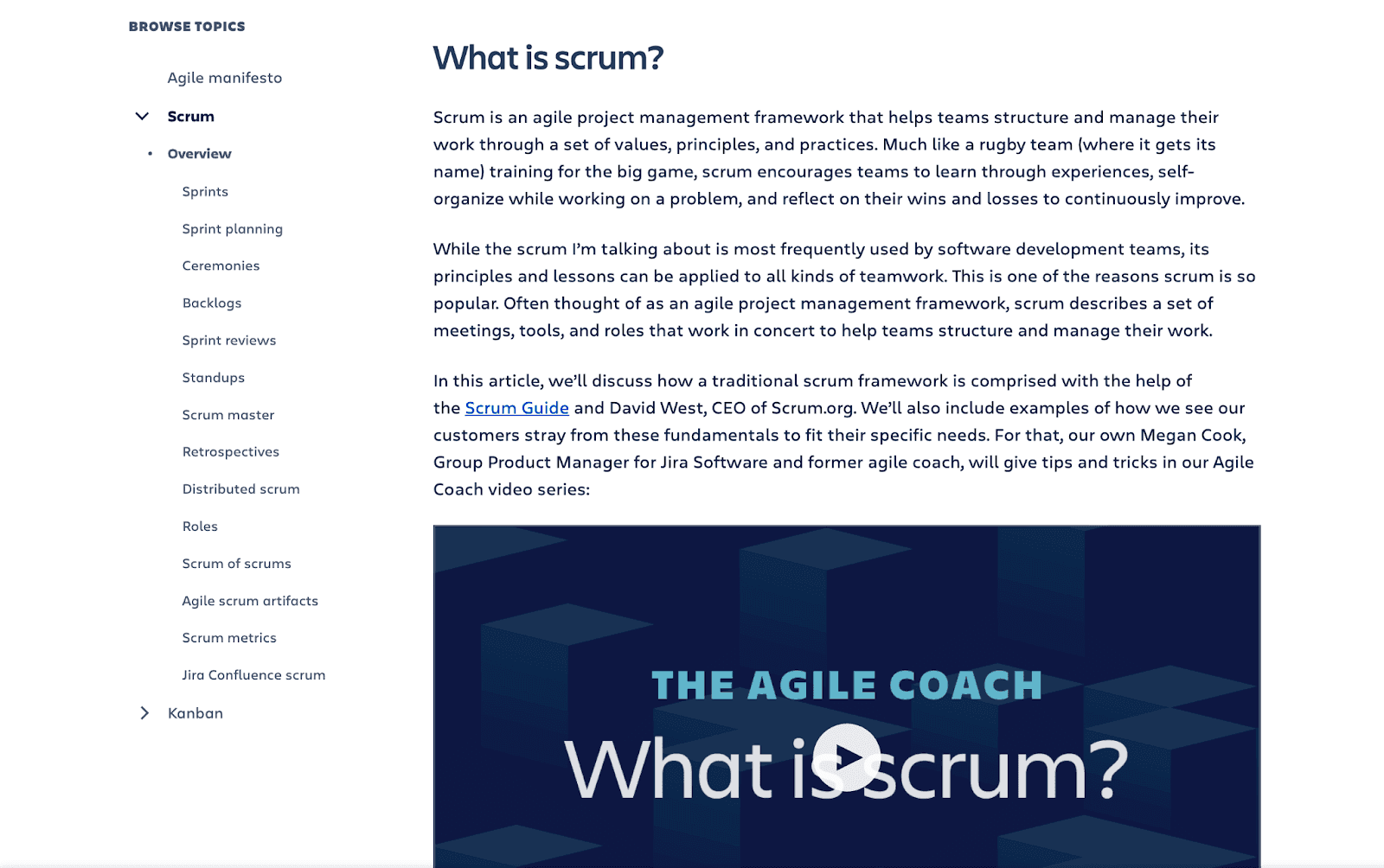
The sidebar of the guide links to every subtopic page and dynamically displays many more pages to further reader discovery. The content is also well interlinked in the body copy of all pages.
Atlassian’s topic cluster even goes three levels deep into subtopics of agile with pages such as Agile sprint reviews.
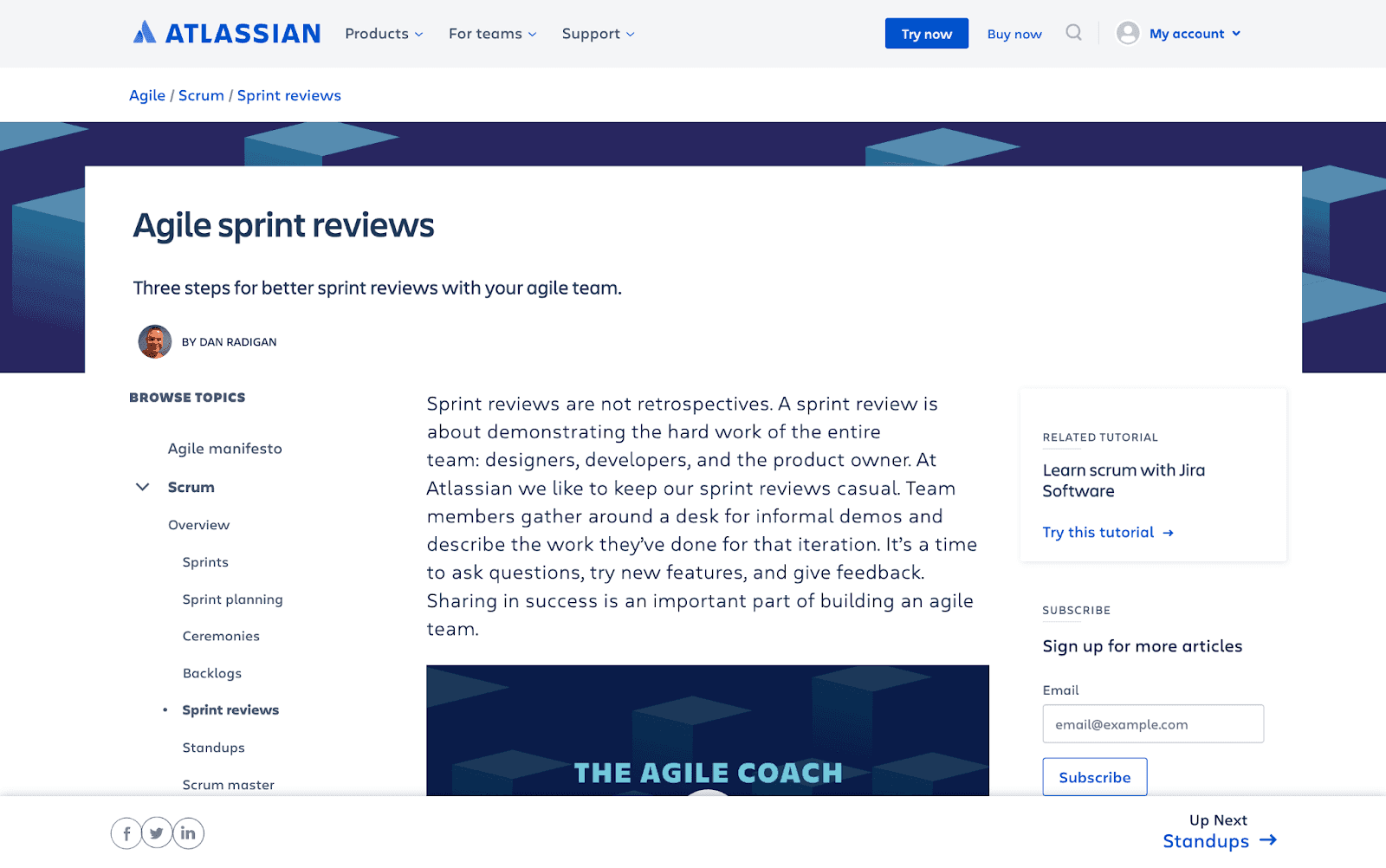
Atlassian implements breadcrumbs on the third-level entity pages to facilitate interlinking among all related pages to the pillar content page. The “Up Next” bottom banner with automatic links to further exploration is a pretty smart idea, too.
Topic Cluster Example #3: Jeff Goins’s Guide to SEO
Jeff Goins is a highly successful writer and marketer who understands how to present content in a way readers and search engines love. His beginner’s guide to SEO is a great example of this.
First, we’ll look at the URL of his pillar content linked here. It’s targeting an excellent, broad topic (e.g., SEO guide):
The body content is crisp, concise, and well-written. It summarizes the main topic and touches on some basic high-level questions a reader might have:
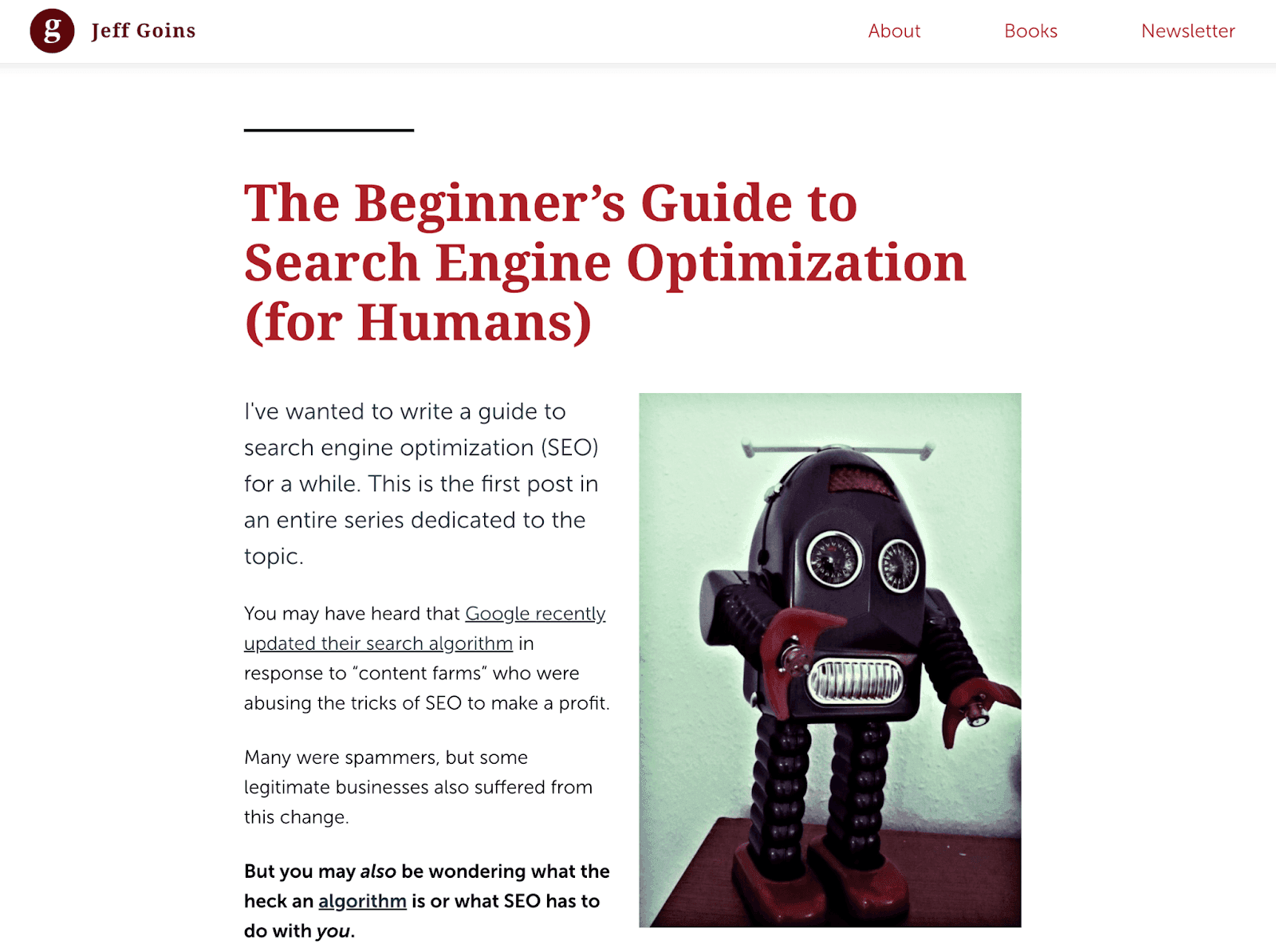
Then, at the bottom, he has internal links to several pieces of related content targeting narrowly-defined subtopics around his pillar content:
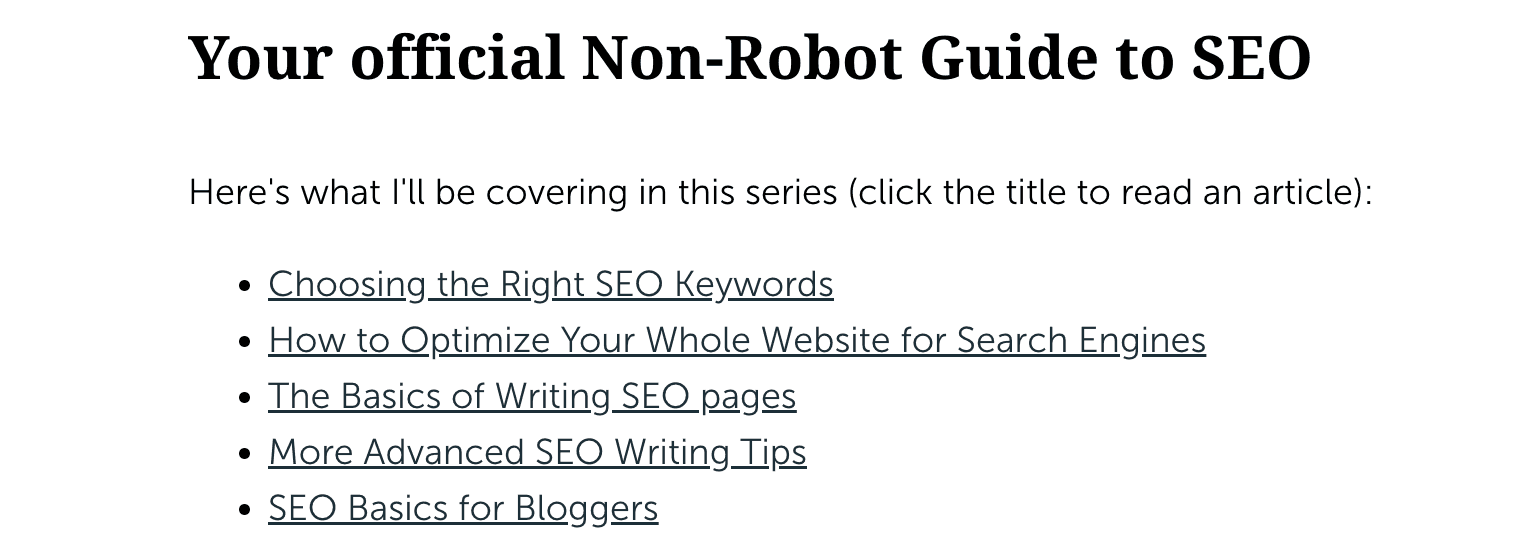
Each of these pieces of sub-content is internally linked to one another, too:
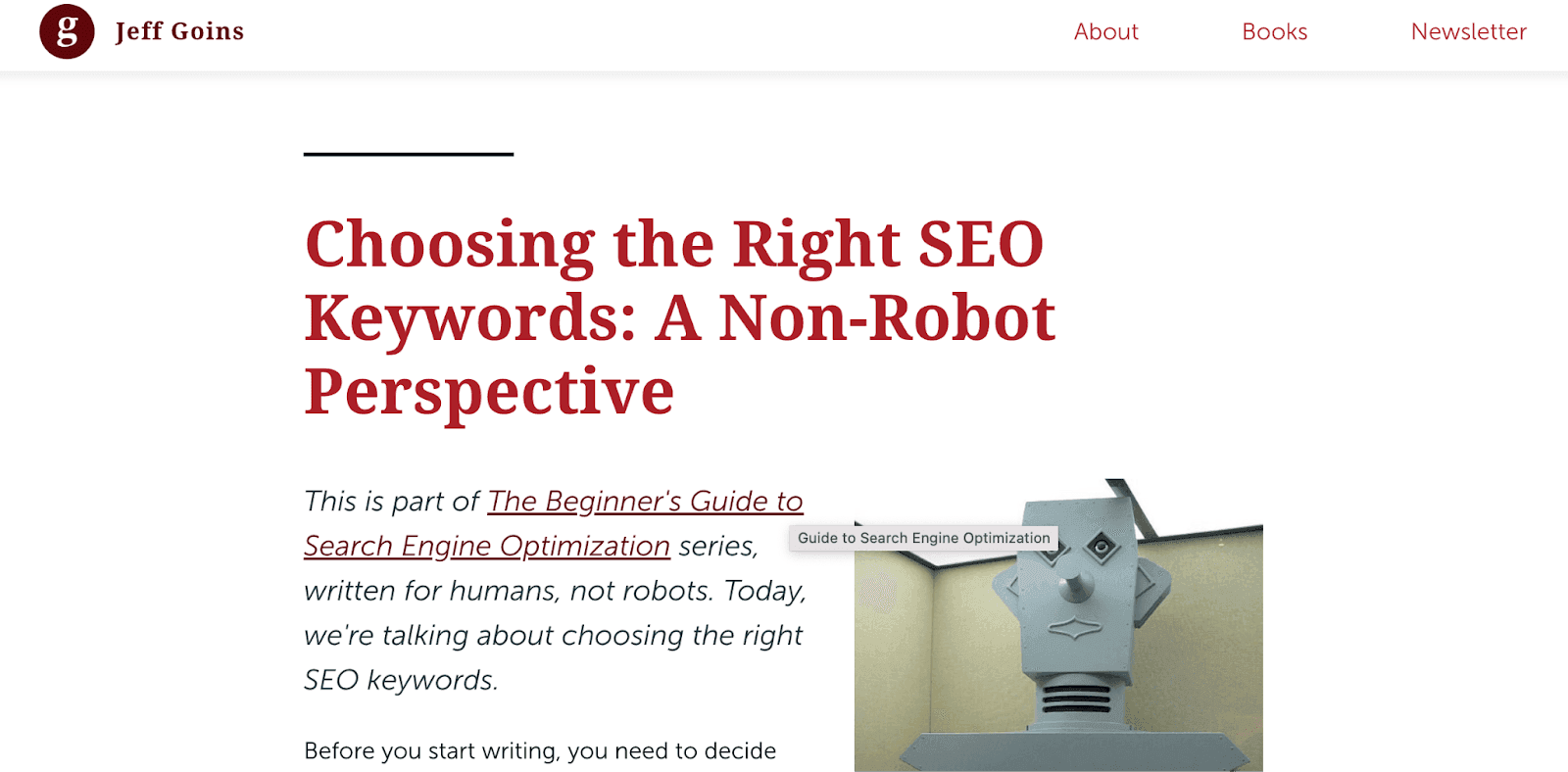
Let’s get down to business and figure out how you can build topic clusters yourself.
Step 1: Select Topics
The first step is to identify topics relevant to your brand and audience. These could include:
- Problems your audience faces. What do your potential customers need help getting done?
- What you want to be known for. What topics do you want to be the Internet’s top authority on?
- Things people use your products for. What do customers buy your product to accomplish?
Step 2: Research Keywords
If we’re targeting topics, does that mean keywords no longer matter?
Not at all.
Keywords remain as crucial as ever. When building out topic clusters though, the key is to create multiple pieces of content with different keyword phrases that all revolve around one central theme.
To do that, we’ll need to select a core keyword topic for our pillar content and several related terms for other pieces of supporting content.
Ahrefs is our favorite keyword tool here at CoSchedule. For the purposes of this article, there’s one specific feature that’s super helpful, too. That’s the ability to identify parent topics related to specific keywords.
If you have a paid Ahrefs account, find the Keyword Explorer, enter a topic, and click the magnifying glass button.
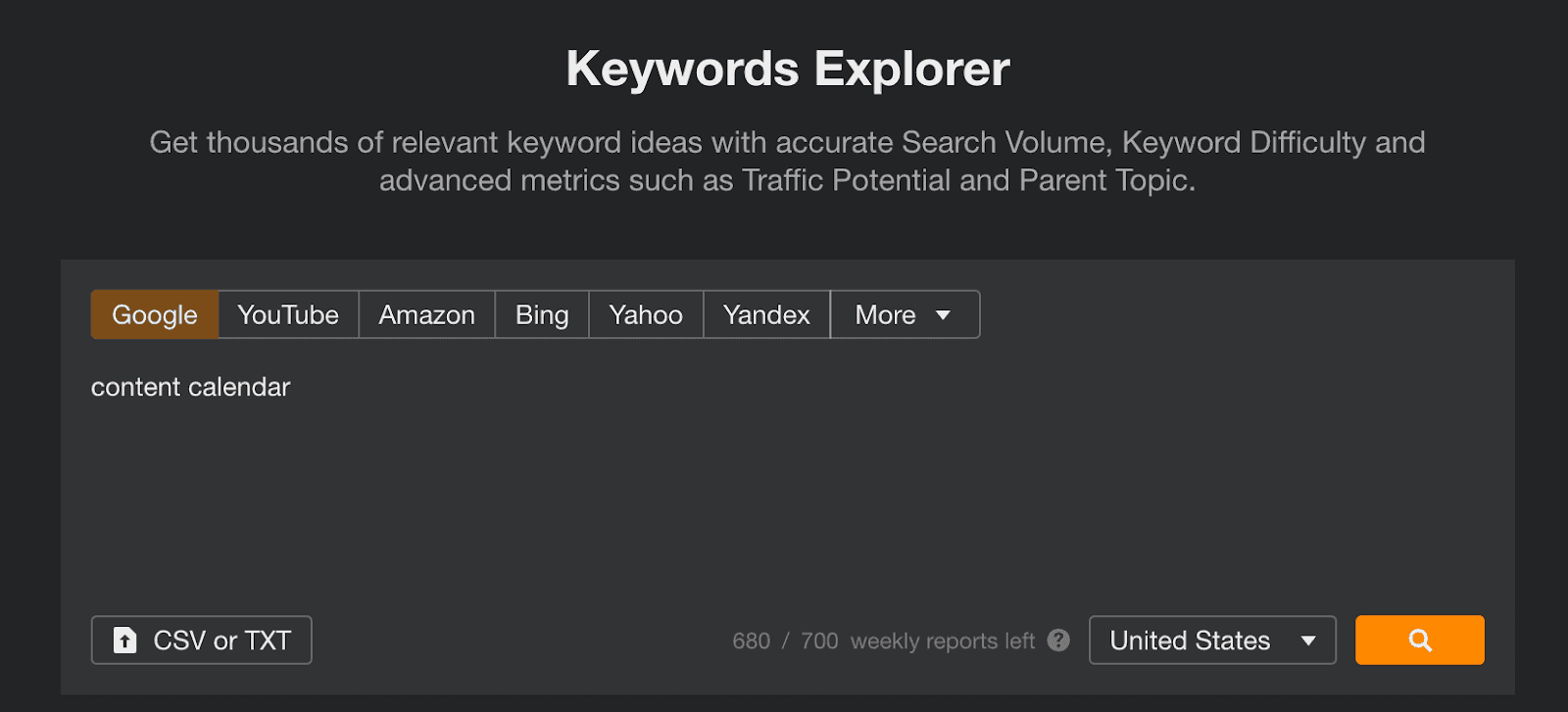
Next, you’ll see a variety of different data for your keyword (including search volume, difficulty, and other things typical with most keyword research tools). However, you’ll also see the parent topic for that keyword:

You can dig in even further to find more related keyword ideas:
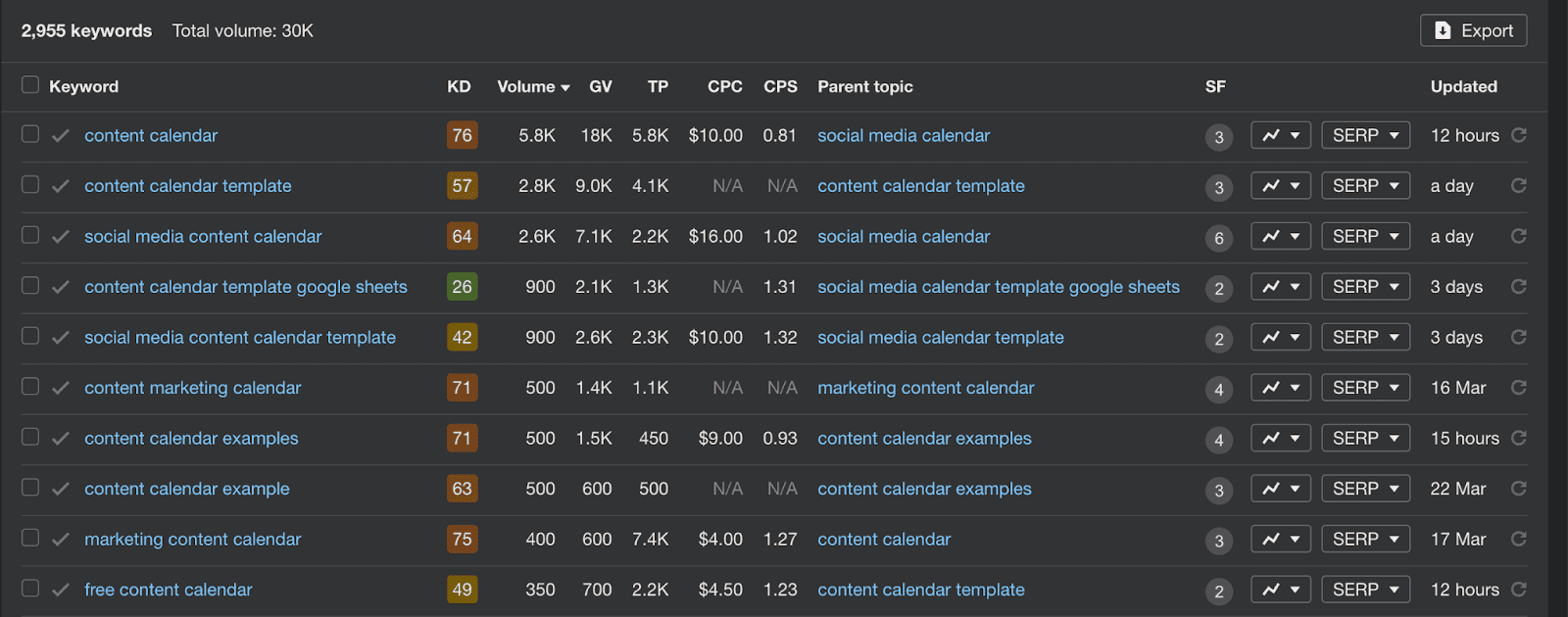
Based on this quick research, we now have:
- A primary topic (identified as the parent topic in Ahrefs). This could be something we’d consider building a piece of pillar content around.
- Tons of related keywords. These are all more narrowly targeted subtopics we could create related pages for and internally link them together around our pillar content.
Powerful stuff.
Step 3: Research Google Knowledge Graph
Google Knowledge Graph is an enormous database of information, providing immediate and factual answers to search queries.
Let’s look at Google’s search result for the query “social media calendar.” 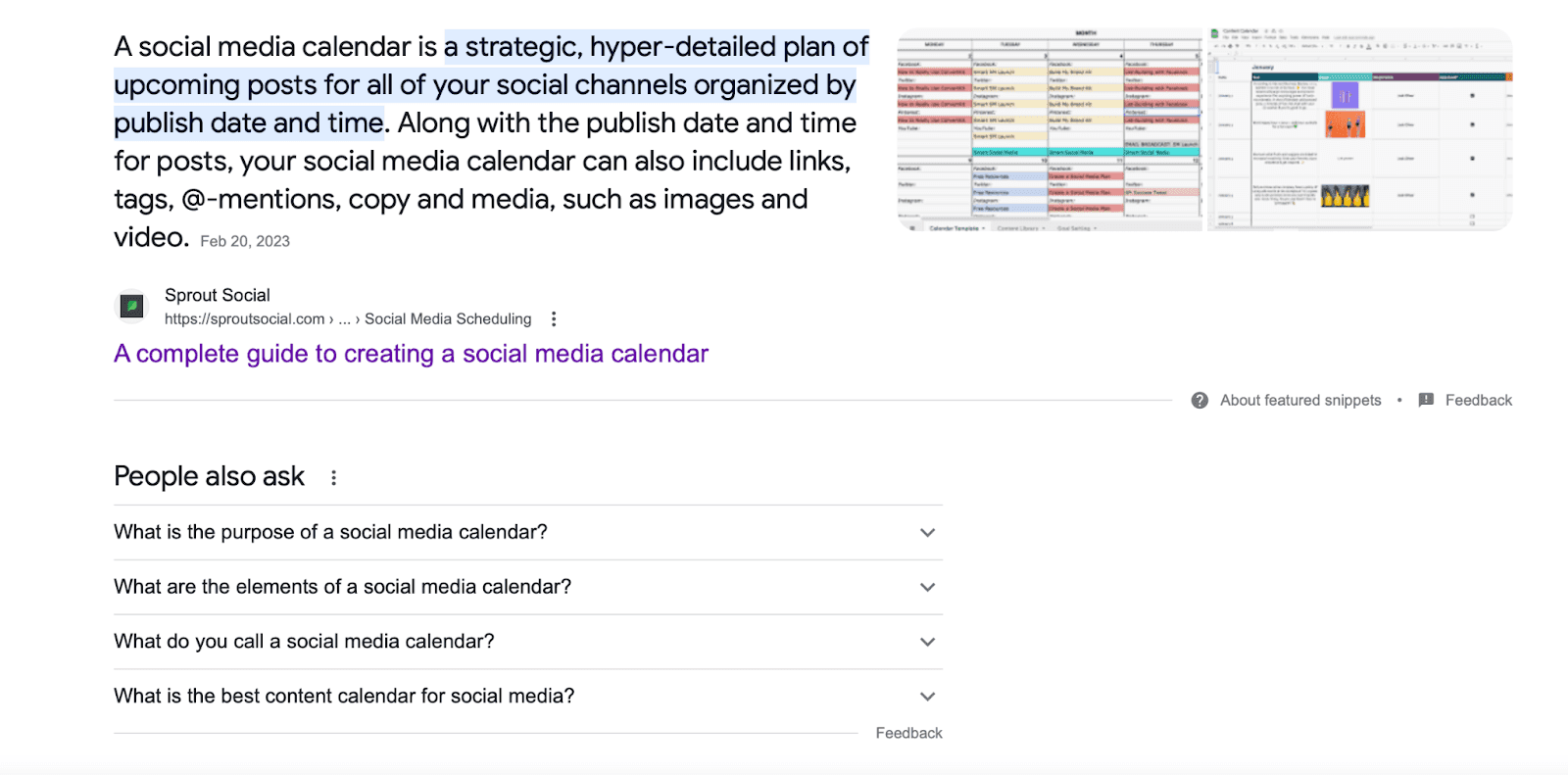
Without a second click, Google Knowledge Graph summarizes basic information and shares frequently asked questions.
SERPs visibility and brand exposure will greatly increase by optimizing a website for Google’s Knowledge Graph.
Step 4: Create A Topical Map
At its finest, a topical map is a content blueprint. It breaks down primary topics into subcategories, creating a structural hierarchy and defining the content needed to achieve topical authority.
Follow these steps to create a robust topical map to dominant SEO:
- Identify a core topic: After conducting keyword research, as done in step two, identify a keyword to stand as the main theme. Choosing a keyword is the first critical step to creating successful content.
- Create a list of related queries: When creating content designed to help users, it’s helpful to first understand popular search queries related to your keyword.
Use the following SERP features to see what people are searching for:
-
- Knowledge Panels
- People Also Ask boxes
- Auto Suggest
- Identify subtopics related to the main theme: Use the list of related queries to identify popular subtopics and cover the fine details of the core topic.
- Create the hierarchy: Connect the subtopics to the main topic using semantic language (i.e., interlinking).
- Produce Content: After creating the hierarchy, use your topical map to start producing quality content.
- Review and revise: As new content is created and published, add or remove subtopics to ensure your map reflects the current focus and structure of content.
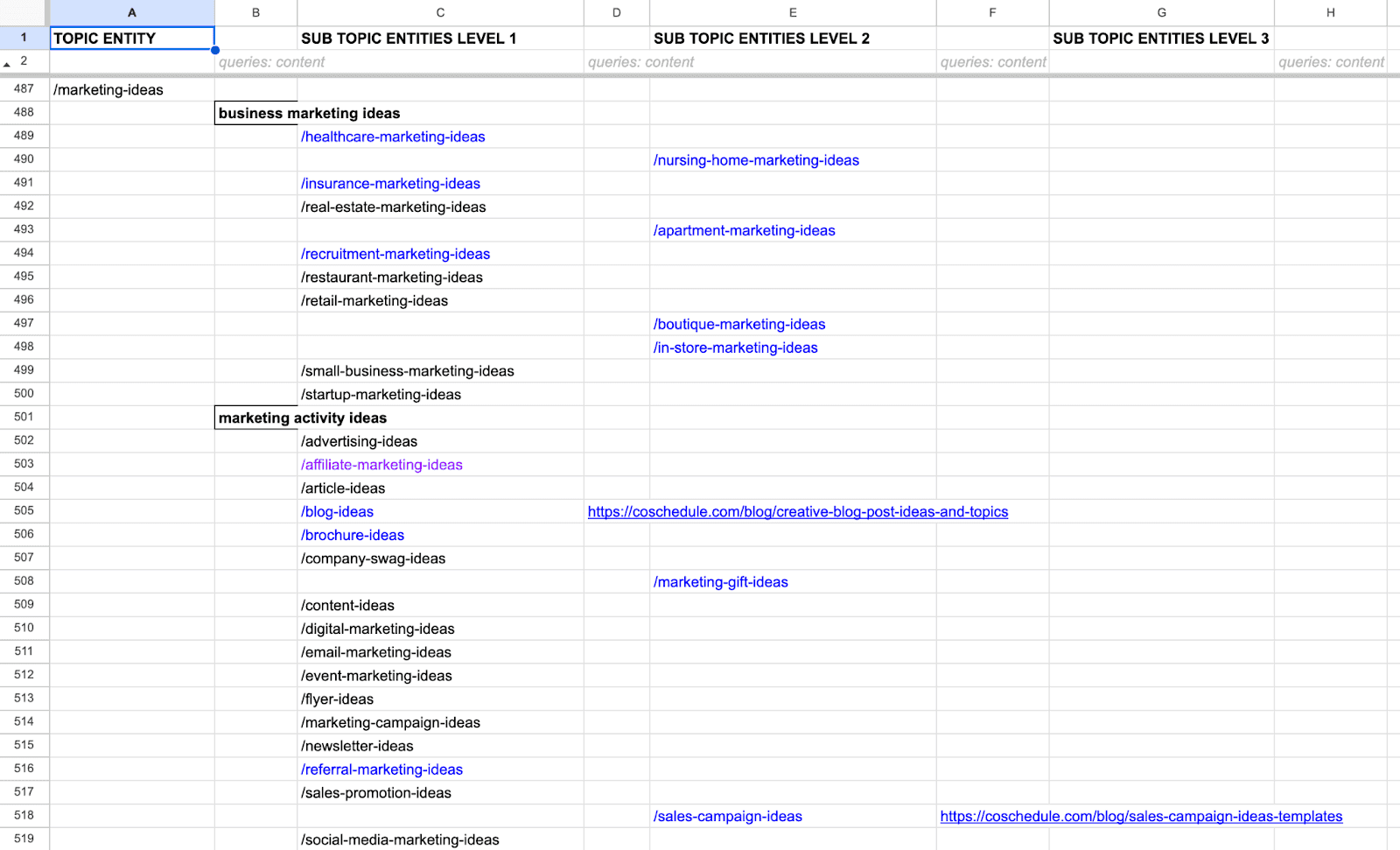
Here is a topical map example that Nathan Ellering made for a marketing ideas topic cluster. The directory begins with the content pillar page of marketing ideas. There are subtopic pages for very targeted types of ideas, such as advertising ideas, nested one folder deeper into the marketing ideas directory linked here.
Step 5: Plan Topically-Themed Content
Now you know what topic you’ll be creating content around. Congrats! You’re on your way to outranking your competition and being known as the topical authority in your industry.
But first, you’ll need to actually create that content.
So, we’ll start by determining which types of content you’ll produce. This could include:
- Website pages. These might include articles within a resource hub or learning center.
- Blog posts. Commonly, this means one core post with several interlinked posts.
- Microsites. An entire mini-site dedicated to one topic could be successful (if microsites are a part of your strategy).
- Videos. This could potentially be a series of videos tackling all aspects of a topic.
We won’t go into the nuts and bolts of content creation in this article. For that info, we’ll direct you to the following posts and resources:
Content Research:
Content Creation:
Turn your brilliant ideas into engaging articles with ease. Discover how our Article Generator can bring your content to life!
Search Engine Optimization
Content Promotion
- Social Media Promotion
- Best Times To Post On Social Media
- Best Time To Send Email
- How To Promote Your Blog
- Content Marketing Promotion Strategy
Topic clusters are simply strategic internal linking opportunities. Broken down, it functions through:
1. Semantic Search
Semantic search refers to a search engine’s attempt to interpret a search query and pinpoint whata user has actually asked. Rather than finding a literal web page match for a keyword, search engines analyze the arrangement of words and determine the contextual meaning behind each search query.
2. Topical Authority
Topical authority describes the degree of credibility that’s earned through producing quality content. The more consistent, comprehensive blog posts, the more search engines, and consumers, categorize you as a subject matter expert.
3. Topic Entities
A topic entity, as defined by Google, is:
Topic Entity
A thing or concept that is singular, unique, well-defined, and distinguishable.
Put another way; it’s any word or phrase entered into a search engine that can be uniquely identified.
4. Search Queries
Search queries refer to a word or phrase entered into a search engine by a user. It’s the literal text used to initiate a search, often containing – or is itself – a keyword.
5. Keywords
A keyword refers to a specific term that defines the content of a web page. For example, say you published a blog post. If everything on that blog (i.e. copy, video, images) was boiled down to a singular idea, there is your keyword.
Users search for similar content in different contexts. And while the exact order of words may differ, a search engine will understand the intended meaning of the search query, and pinpoint a keyword.
6. Google Knowledge Graph
Google Knowledge Graph is a database from which Google pulls relevant information and places it into an infobox beside the search result.
7. Content Pillars
Content pillars refers to a substantial piece of content, on a specific topic, broken into derivative sections and materials.
8. Topic Mapping
Topic mapping is simply a visualization of connected concepts.
9. Content Hierarchy & Website Structure
Content hierarchy describes the strategic arrangement of information on a web page. It places the most important content higher on the page, quickly grabbing consumer attention, and the less important content near the bottom.
10. Interlinking
Interlinking refers to any hyperlink on a web page leading to another article on the same site.
Utilizing topic clusters sounds more complex than it really is. If you’re capable of planning several pieces of content around one idea, making it presentable, and linking it all together, then you’re capable of putting this principle into practice.
To recap what you learned, let’s touch on a few key points:
- Topic clusters haven’t replaced the need for keywords. Instead, they’ve pushed marketers to rethink keyword research, going beyond lone terms and thinking more broadly about topics as a whole and the entities a topic covers, regardless of term search volumes.
- Creating multiple pieces of high-quality content around one topic helps establish authority. This one may seem somewhat obvious, but having various pieces of content targeting different aspects of a single topic shows people and bots alike that you’re a useful resource. That leads to more rankings, traffic, and conversions.
- Topic clusters aren’t difficult to implement. Sure, creating several pieces of long-form content will take time. So will all the planning and research phases involved. But, if you were going to create multiple pieces eventually anyway, why not build them all around one topic, and completely own it on the web?
This piece was originally published August 28, 2017, as a blog post. We refreshed and repurposed this article in our content marketing knowledge hub in June 2023. Nathan Ellering and Brier Gurholt contributed to this piece.

